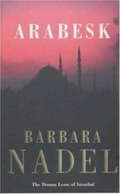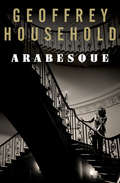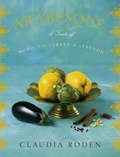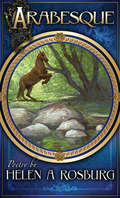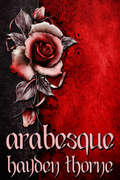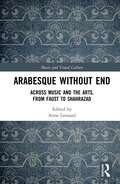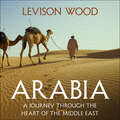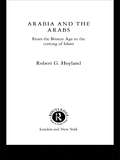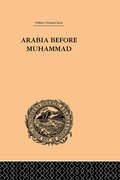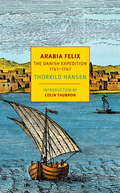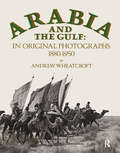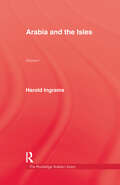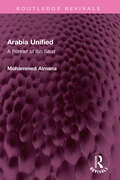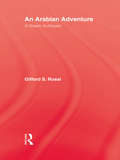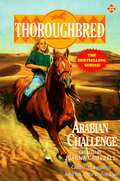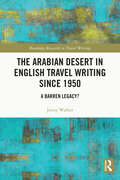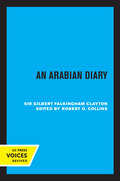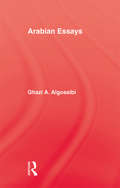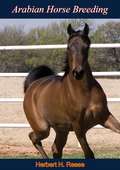- Table View
- List View
Arabesk (Inspector Ikmen Mystery 3): A powerful crime thriller set in Istanbul
by Barbara NadelInspector Ikmen and Inspector Suleyman return in Arabesk, Barbara Nadel's third novel in the gripping Inspector Ikmen series. Perfect for fans of Jason Goodwin and Adrian Magson.'The delight of the Nadel book is the sense of being taken beneath the surface of an ancient city which most visitors see for a few days at most' - Independent When the wife of one of Istanbul's best known popular singers is found dead and his baby daughter missing, the newly promoted Inspector Suleyman, scion of one of Turkey's most aristocratic families, finds himself plunged into the magnificently vulgar, overblown world of Arabesk music, dominated by an ageing star, the monstrous chanteuse, Tansu.What readers are saying about Arabesk:'Written with wit and style, her plotting and characterisation are as sharp and original as ever''A city and its crowded streets and ancient cultures come vividly alive - colours, sounds, smells, heat and dust lifting from the page''Packed to the gills with cultural insights'
Arabesque (Murder Room #63)
by Geoffrey HouseholdA superb thriller, romance and spy novel from 'The best in his field since Buchan' ObserverArabesque is a love story that takes us to the colourful crossroads of the Middle East at the height of World War IIArmande Herne - half English, half French and impassively beautiful - is sitting out the war in Beirut with no visible means of support. The rumour is she's a spy. But, as conflict between British and French, Jew and Arab whirl around her, it is a British security sergeant who finds her. Soon they are embroiled in a plot, rich with adventure and intrigue.
Arabesque
by Geoffrey HouseholdA superb thriller, romance and spy novel from 'The best in his field since Buchan' ObserverArabesque is a love story that takes us to the colourful crossroads of the Middle East at the height of World War IIArmande Herne - half English, half French and impassively beautiful - is sitting out the war in Beirut with no visible means of support. The rumour is she's a spy. But, as conflict between British and French, Jew and Arab whirl around her, it is a British security sergeant who finds her. Soon they are embroiled in a plot, rich with adventure and intrigue.
Arabesque
by Geoffrey HouseholdIn war-torn Lebanon, a beautiful French woman fights a war of spy versus spy There is no privacy in Beirut. In the hotel lobbies and high-class bars of this beautiful Eastern capital, intelligencers of every stripe hide in plain sight: British spies and Nazi moles, Free French operatives and the lackeys of Vichy France. Stalin has his men here, as do the Zionists who would turn British Palestine into a haven for the Jewish people. There are agents of every race, gender, and nationality--and they are all at one another's throats. Armande Herne is not one of them--but she will be soon enough. A French woman raised in England, Armande came to Beirut after her husband joined the navy. When the French army hands the city over to the British, an arms deal draws Armande into the shadowy side of this city of intrigue, taking her on a desert adventure that will change the war--or leave her dead in the sand.
Arabesque
by Claudia RodenIn the 1960s Claudia Roden introduced Americans to a new world of tastes in her classicA Book of Middle Eastern Food. Now, in her enchanting new book,Arabesque, she revisits the three countries with the most exciting cuisines today—Morocco, Turkey, and Lebanon. Interweaving history, stories, and her own observations, she gives us 150 of the most delectable recipes: some of them new discoveries, some reworkings of classic dishes—all of them made even more accessible and delicious for today’s home cook. From Morocco, the most exquisite and refined cuisine of North Africa: couscous dishes; multilayered pies; delicately flavoredtagines; ways of marrying meat, poultry, or fish with fruit to create extraordinary combinations of spicy, savory, and sweet. From Turkey, a highly sophisticated cuisine that dates back to the Ottoman Empire yet reflects many new influences today: a delicious array of kebabs, fillo pies, eggplant dishes in many guises, bulgur and chickpea salads, stuffed grape leaves and peppers, and sweet puddings. From Lebanon, a cuisine of great diversity: a wide variety ofmezze(those tempting appetizers that can make a meal all on their own); dishes featuring sun-drenched Middle Eastern vegetables and dried legumes; and national specialties such askibbeh, meatballs with pine nuts, and lamb shanks with yogurt. Claudia Roden knows this part of the world so intimately that we delight in being in such good hands as she translates the subtle play of flavors and simple cooking techniques to our own home kitchens.
Arabesque
by Helen A. RosburgFrom ancient past to present, Helen A Rosburg's Arabesque explores the relationships between humans and nature, time, the grave, and beyond. With its meditations on the physical world, its whimsical fairy tales, and its haunting love stories, this collection awakens readers to the magic and wonder of life.
Arabesque
by Hayden ThorneAn ambitious young princess, Ulrike, turns to the dark arts in order to become queen despite her younger sister’s warnings of a fatal consequence to mortgaging her soul. She succeeds, yet Ulrike finds herself trapped in a hateful marriage, her mind slowly being devoured by her powers, while conceiving and giving birth to a boy.Alarick -- “the bastard prince” -- becomes the court’s favorite object of mockery because of the scandal of his conception, his mother’s spiraling madness compounding his ordeal. When Alarick falls in love with a childhood friend, Roald von Thiessen, the added sin of an unnatural romance gets caught up in a tumultuous aristocratic environment that’s rife with hypocrisy, cruelty, betrayal, and murder.Forcibly separated from each other during a bloody uprising, Roald and Alarick become helplessly ensnared in nightmarish adventures designed to twist their characters and destroy their minds in the process. The young lovers fight for their souls and a way back to each other in a world weighed down by the forces of dark and light magic, and gods grapple with each other over mortal destinies. Arabesque is more than a gothic, homoerotic retelling of the Snow White folktale. It is at once allegory and a darkly satirical account of contemporary issues such as misogyny, homophobia, and the process of reparative therapy.
The Arabesque from Kant to Comics (Routledge Advances in Art and Visual Studies)
by Cordula GreweThe Arabesque from Kant to Comics tracks the life and afterlife of the arabesque in its surprising transformation from an iconoclastic literary theory of early German Romanticism to aesthetic experimentation in both avant-garde art and popular culture. Its explosive growth in popularity was followed by an inevitable taming as arabesques became staples in book illustration, poetry publications, and even the decoration of printed scores. The subversive potential of the arabesque was preserved in one of its most surprising offspring, the comic strip: born at the moment when the cholera pandemic first swept through Europe, the comic translated the arabesque’s rank growth into unnerving lawlessness and sequences of contagious visual slapstick. Focusing roughly on the period between 1780 and 1880, this book illuminates the intersecting histories of avant-garde theories of writing, visual culture, and even the disciplinary origins of art history. In the process, it explores media history and intermediality, social networks and cultural transfer, as well as the rise of new and nontraditional art forms. This book will be of particular interest to scholars of art history, intellectual history, European art, aesthetics, book illustration, material culture, reproduction, comics, and German history.
Arabesque without End: Across Music and the Arts, from Faust to Shahrazad (Music and Visual Culture)
by Anne LeonardFeaturing multidisciplinary research by an international team of leading scholars, this volume addresses the contested aspects of arabesque while exploring its penchant for crossing artistic and cultural boundaries to create new forms. Enthusiastically imported from its Near Eastern sources by European artists, the freely flowing line known as arabesque is a recognizable motif across the arts of painting, music, dance, and literature. From the German Romantics to the Art Nouveau artists, and from Debussy’s compositions to the serpentine choreographies of Loïe Fuller, the chapters in this volume bring together cross-disciplinary perspectives to understand the arabesque across both art historical and musicological discourses.
Arabesques
by Anton ShammasA luminous, inventive, and deeply personal exploration of living in the liminal space between Jewish and Arab, ancient and modern, by a gifted Palestinian writer.Chosen by The New York Times as one of the best books of 1988, Arabesques is a luminous novel that engages with history and politics not as propaganda but as literature. That engagement begins with the language in which the book is written: Anton Shammas, from a Palestinian Christian family and raised in Israel, wrote in Hebrew, as no Arab novelist had before. The choice was provocative to both Arab and Jewish readers.Arabesques is divided into two sections: &“The Tale&” and &“The Teller.&” &“The Tale&” tells of several generations of family life in a rural village, of the interplay of past and present, of how memory intersects with history in a part of the world where different people have both lived together and struggled against each other for centuries. &“The Teller&” is about the writer&’s voyage out of that world to Paris and the United States, as he comes into his vocation as a writer, and raises questions about the authority of the storyteller and the nature of the self. Shammas&’s tour de force is both a personal and a political narrative—a reinvention of the novel as a way of envisioning and responding to historical and cultural legacies and conflicts.
Arabia: A Journey Through The Heart of the Middle East
by Levison WoodShortlisted for the 2019 Edward Stanford Award '[A] rollicking Boys' Own adventure' - Spectator'This heart-stopping personal account of historic Arabia today.' - Compass MagazineFollowing in the footsteps of Lawrence of Arabia and Wilfred Thesiger, Arabia is an insight into Levison Wood's most complex and daring expedition yet: an epic and unprecedented 5000-mile journey through 13 countries, circumnavigating the Arabian Peninsula.Honest, reflective and poignant, Arabia is a historical, religious and spiritual journey, through some of the harshest and most beautiful environments on Earth. Exploring the Middle East through the lives, hearts and hopes of its people, Levison Wood challenges the perceptions of an often misunderstood part of the world, seeing how the region has changed and examining the stories we don't often hear about in the media.
Arabia: A Journey Through The Heart of the Middle East
by Levison WoodThe award-winning TV adventurer and travel writer's enthralling account of his 5,000-mile expedition around the Arabian Peninsula, from Iraq to Lebanon.Following in the footsteps of great explorers such as Lawrence of Arabia and Wilfred Thesiger, Arabia is Levison Wood's account of his most complex expedition yet: circumnavigating the Arabian Peninsula. Travelling through some of the harshest and most beautiful environments on earth, he seeks to challenge our perceptions of an often misunderstood part of the world, seeing how the region has changed and examining the stories we don't often hear about in the media. (P)2018 Hodder & Stoughton Limited
Arabia and the Arabs: From the Bronze Age to the Coming of Islam
by Robert G. HoylandLong before Muhammed preached the religion of Islam, the inhabitants of his native Arabia had played an important role in world history as both merchants and warriorsArabia and the Arabs provides the only up-to-date, one-volume survey of the region and its peoples, from prehistory to the coming of IslamUsing a wide range of sources - inscriptions, poetry, histories, and archaeological evidence - Robert Hoyland explores the main cultural areas of Arabia, from ancient Sheba in the south, to the deserts and oases of the north. He then examines the major themes of*the economy*society*religion*art, architecture and artefacts*language and literature*Arabhood and ArabisationThe volume is illustrated with more than 50 photographs, drawings and maps.
Arabia Before Muhammad
by De Lacy O'LearyFirst Published in 2000. Routledge is an imprint of Taylor & Francis, an informa company.
Arabia Felix: The Danish Expedition of 1761-1767
by Colin Thubron James Mcfarlane Kathleen Mcfarlane Thorkild HansenA riveting account of a landmark expedition that left only one survivor, now back in print for the first time in decades.Arabia Felix is the spellbinding true story of a scientific expedition gone disastrously awry. On a winter morning in 1761 six men leave Copenhagen by sea—a botanist, a philologist, an astronomer, a doctor, an artist, and their manservant—an ill-assorted band of men who dislike and distrust one another from the start. These are the members of the Danish expedition to Arabia Felix, as Yemen was then known, the first organized foray into a corner of the world unknown to Europeans. The expedition made its way to Turkey and Egypt, by which time its members were already actively seeking to undercut and even kill one another, before disappearing into the harsh desert that was their destination. Nearly seven years later a single survivor returned to Denmark to find himself forgotten and all the specimens that had been sent back ruined by neglect. Based on diaries, notebooks, and sketches that lay unread in Danish archives until the twentieth century, Arabia Felix is a tale of intellectual rivalry and a comedy of very bad manners, as well as an utterly absorbing adventure.Arabia Felix includes 33 line drawings and maps.
Arabia & The Gulf
by Andrew WheatcroftFirst published in 1982. The art of photography is now an immensely popular hobby throughout the world. However, when it first started it was available only to a very few people who had the money and determination to indulge in this activity. Then as now, each photograph is a reflection of the interests and tastes of the photographer, be he amateur or professional. The present book is not just a collection o f photographs but rather an illustrated historical record. In other words it is a chronicle which is brought dramatically to life by the photographs. As its title indicates the book deals with a region about which very little was known in the West during the nineteenth and early twentieth century. It covers the region not only geographically but also sociologically and over a fairly long period of time. It spans the region from the heart of Arabia, through Western Arabia (Jeddah, Mecca and Medina), Yemen, Oman and the Gulf. It depicts the life of the Arab, not only rulers but also the ordinary people in their daily activities. These photographs also show the changes which have taken place over the period from 1880 to 1950, giving the reader an opportunity to link the past with the present.
Arabia & The Isles (The\kegan Paul Arabia Library)
by IngramsFirst Published in 1998. Routledge is an imprint of Taylor & Francis, an informa company.
Arabia Unified: A Portrait of Ibn Saud (Routledge Revivals)
by Mohammed AlmanaFirst Published in 1980 Arabia Unified presents an insider’s view of Saudi Arabia’s history and the remarkable career of its founder. The book covers the capture of Riyadh from the Saud family’s greatest rivals, the Rashid’s, and the eventual defeat of Al Rashid at the battle of Rowdhat Muhanna; the elimination of Ibn Saud’s most implacable enemies; the incorporation of the provinces of Asir and Hejaz into the kingdom; and the rise, rebellion, and eventual defeat of the puritanical Ikhwan tribesmen. Author describes life with the King’s Bedouin warriors and the intricacies of the Arabian tribal system; the confrontation with the Imam Yahya of the Yemen; and finally, the start of the oil exploration which was to transform the country. The author concludes with his own account of the King’s character and achievements. Full of humor, anecdote and reminiscence, an accurate and personal record, this book is essential reading for all who wish to know about the history of Saudi Arabia.
Arabian Adventure
by RossiFirst published in 1996. Routledge is an imprint of Taylor & Francis, an informa company.
Arabian Challenge (Thoroughbred #22)
by Joanna CampbellFor as long as she can remember, Cindy Blake has longed to ride a Thoroughbred in a world-class race. And now that she's 16, Cindy's dream is finally coming true. She'll ride Wonder's Champion, the Triple Crown winner, in Arabia's Dubai Cup! Cindy's competition is tough. She'll be racing against the best horses and jockeys in the world--including her friend and teacher, Ashleigh Griffen!
The Arabian Desert in English Travel Writing Since 1950: A Barren Legacy? (Routledge Research in Travel Writing)
by Jenny WalkerBroadly this book is about the Arabian desert as the locus of exploration by a long tradition of British travellers that includes T.E. Lawrence and Wilfred Thesiger; more specifically, it is about those who, since 1950, have followed in their literary footsteps. In analysing modern works covering a land greater than the sum of its geographical parts, the discussion identifies outmoded tropes that continue to impinge upon the perception of the Middle East today while recognising that the laboured binaries of "East and West", "desert and sown", "noble and savage" have outrun their course. Where, however, only a barren legacy of latent Orientalism may have been expected, the author finds instead a rich seam of writing that exhibits diversity of purpose and insight contributing to contemporary discussions on travel and tourism, intercultural representation and environmental awareness. By addressing a lack of scholarly attention towards recent additions to the genre, this study illustrates for the benefit of students of travel literature, or indeed anyone interested in "Arabia", how desert writing, under the emerging configurations of globalisation, postcolonialism and ecocriticism, acts as a microcosm of the kinds of ethical and emotional dilemmas confronting today’s travel writers in the world’s most extreme regions.
An Arabian Diary
by Sir Gilbert ClyatonThis personal diary of six months of diplomacy and travel in Arabia represents and impressive document to the quiet ability and resourcefulness of one of Great Britain's leading officials in the Middle East in the 1920's. The sudden expansion of the Arabian Sultanate of Najd under the leadership of 'Abd-al-'Aziz ibn Sa'ud after the First World War presented a clear danger to British interests in the Middle East and threatened the strategically important Arabian corridor to India. To resolve this project the British government selected Sir Gilbert Clayton as their envoy to negotiate a settlement of differences and to determine the frontier between Saudi Arabia and the British Mandates of Trans-Jordan and Iraq. Sir Gilbert Falkingham Clayton (1875-1929) was a quiet, able soldier, administrator, and diplomat who had come out to eh Middle East during the reconquest of the Sudan and remained as a political officer in theSudan service, secretary to the Governor-General of the Sudan, Sir Reginald Wingate, and finally the Sudan agent at Cairo. At the outbreak of the First World War, Clayton served as the director of Military Intelligence an forged that remarkable intelligence team which included among others Leonard Woolley, George Lloyd, and T.E. Lawrence. Experience and resourceful, Clayton was an obvious choice to travel to the tents of Iban Sa'ud where the autumn of 1925 he negotiated the Bahra and Hadda Agreements fixing the frontiers of Saudi Arabia with Trans-Jordan and Iraq and cementing friendship between Britain and Ibn Sa'ud. These results represent a brilliant triumph of personal diplomacy which protected British interests and inaugurated the lifelong friendship between Sir Gilbert and Ibn Sa'ud. The story of these negotiations and Sir Gilbert's subsequent mission to the Imam of Yemen as the first official representative of the British government to visit San'a' are told in this valuable historical diary. This title is part of UC Press's Voices Revived program, which commemorates University of California Press's mission to seek out and cultivate the brightest minds and give them voice, reach, and impact. Drawing on a backlist dating to 1893, Voices Revived makes high-quality, peer-reviewed scholarship accessible once again using print-on-demand technology. This title was originally published in 1969.
Arabian Essays (500 Tips)
by AlgosaibiFirst Published in 1982. Routledge is an imprint of Taylor & Francis, an informa company.
Arabian Horse Breeding
by Herbert H. ReeseIn ARABIAN HORSE BREEDING, which was first published in 1953, the author has put into words the culmination of a lifetime of practical experience in the breeding, raising and training of the Arabian horse. Beginners, as well as seasoned horse breeders, will find this volume useful and enlightening in their day to day contact with the ‘Horse of the Desert.’ Here are fully explained both in text and beautiful drawings by Gladys Brown Edwards, foremost horse artist, what are the characteristics of an Arabian, what constitutes good conformation, how to breed Arabians, how to care for and feed the young Arabian colt, how to develop desirable characteristics and good habits right from the start. Written by a former manager of the world-renowned W. K. Kellogg’s Arabian Horse Ranch in Pomona, California, ARABIAN HORSE BREEDING belongs on the library shelf of everyone interested in this most desirable breed.
The Arabian Horse (Edge Books: Horses)
by Carrie A. BraulickThe proud, graceful look of the Arabian horse demands attention. Throughout its long history, the Arabian has shown courage in wars, strength in long races, and great loyalty to its owners. It's easy to see why the oldest breed of horse continues to attract new admirers. Each fact-filled page in the Edge Books Horses set offers an exciting introduction to a horse breed. Learn all about the history of the breed, its unique traits, primary use, training, equipment, and more. Captivating photographs, fast facts, and side bars showcase these magnificent animals in action.
